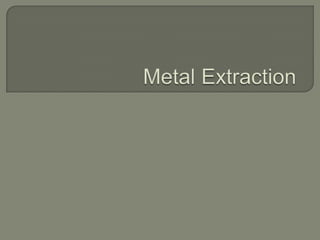
Metal extraction
- 2. Metal Ores Metals are usually found in ores containing minerals They are combined with oxygen or sulfur to form oxides or sulfides Sulfide ores are converted to oxides by heating them in the air, which is called ‘roasting’, e.g. zinc sulfide to zinc oxide ZnS(s) + 1½O2(g)ZnO(s) + SO2(g) zinc sulfide oxygen zinc oxide sulfur dioxide
- 3. Environmental Problems When roasting sulfide ores, sulfur dioxide is produced as a waste product This is a contributor to acid rain if it is allowed to escape into the atmosphere as it reacts in the air to form sulfuric acid However it can be converted to sulfuric acid in controlled conditions which can then be sold for a variety of purposes SO2(g) + H2O(g) + ½O2(g)H2SO4(l) sulfur dioxide sulfuric acid oxygen water
- 4. Extraction of Metals To obtain the metal its ore, a reducing agent is used to remove the oxygen, in a reduction reaction. Examples of some reducing agents; Coke (an impure form of carbon) Hydrogen (made from methane and water) A more reactive metal may be used. Electrolysis can also be used for more reactive metals.
- 5. Reduction of Metal Ores For the extraction of iron, manganese and copper the reducing agents are carbon and carbon monoxide. These are cheap because coke can be used which is cheaply produced by heating coal in the absence of air. The extraction of iron is done in a blast furnace which reaches temperatures of 2000K. Fe2O3(s) + 3CO(g) 2Fe(l) + 3CO2(g) Carbon Monoxide Carbon Dioxide Haematite Iron
- 6. Reduction of Metals Manganese is produced by the reduction of its oxide with carbon. 2MnO(s) + C(s) 2Mn(l) + CO2(g) Copper used to be produced this way but nowadays some ores are converted in to solutions containing Cu2+ ions. The copper is extracted by reducing with scrap iron. Cu2+(aq) + Fe(s) Cu(s) + Fe2+(aq) This is ‘greener’ as no CO2 is produced and scrap iron is cheap and readily available. Also, the solution can be made from low grade ore so it is readily available
- 7. Extracting Other Metals Some metals can’t be extracted using carbon reduction, such as aluminium, titanium and tungsten. Aluminium can’t because it is more reactive than carbon. Titanium and tungsten can’t because it would form a metal carbide which would make the metal brittle.
- 8. Extraction of Aluminium Aluminium is extracted from purified bauxite ore (mainly Al2O3) The oxide is dissolved in molten cryolite, which forms a solution which melts at around 1240K (Al2O3 melts at 2435K therefore less energy is required The solution is electrolysed so the main cost of the process is electricity which makes economic sense where cheap electricity is available
- 9. Extraction of Aluminium Aluminium is produced at negative electrode 2Al3+ +6e- 2Al Oxygen is produced at the positive electrode 3O2- 1½O2 + 6e- This gives an overall equation of: Al2O3(l) 2Al(l) + 1½O2(g)
- 10. Extraction of Titanium As titanium can’t be reduced with carbon, it is reduced by sodium or magnesium This is an expensive process as the titanium oxide is first converted to titanium chloride by reacting it with coke and chlorine at 1173K TiO2(s) + 2C(s) + 2Cl2(g) TiCl4(l) + 2CO(g) The titanium chloride is then reduced by sodium or magnesium into titanium under an inert argon atmosphere at 1300K TiCl4(l) + 4Na(l) Ti(l) + 4NaCl(l)
- 11. Extraction of Tungsten Tungsten is extracted from its oxide, WO3, by reduction with hydrogen at high temperatures WO3 + 3H2 W + 3H2O However, there is some risk as hydrogen is a flammable gas, so using it as a reducing agent is a last resort.
- 12. Effects on the Environment Recycling scrap metals has many environmental and economic advantages It reduces the amount of scrap metal in landfill and it has already been extracted from its ore so energy isn’t required again Melting the scrap metal does not in itself produce carbon dioxide unlike extracting metals from their ores however the energy needed to melt the metal will